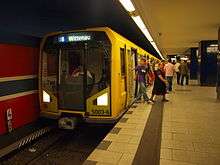BVG Class H
| BVG Class H | |
|---|---|
 A H-type train | |
| In service | 1995-present |
| Manufacturer | Adtranz |
| Built at | Hennigsdorf |
| Constructed | 1995-2001 |
| Entered service | 1995 |
| Number built | 46 trains |
| Formation |
6 per train set DT–M1–M2–M2–M1–DT |
| Fleet numbers | 5001 - 5046 |
| Capacity | 296 seated; 1,624 standing; 2 PIW spaces |
| Operator(s) | Berliner Verkehrsbetriebe |
| Line(s) served | U5, U6, U7, U8 & U9 |
| Specifications | |
| Car body construction | Aluminium-alloy double-skinned construction |
| Car length | 0.09874 m |
| Width | 0.0265 m |
| Height | 0.0180 m |
| Doors | 0.0180 m, 8 per car |
| Maximum speed | 80 km/h (50 mph) |
| Weight | 226.8t /335.9 t (laden) |
| Power output | 2.24 MW (3,000 hp) |
| Transmission | WN Drive |
| Acceleration | 1.0 m/s2 |
| Deceleration |
1.2 m/s2 (service) 1.3 m/s2 (emergency) |
| Auxiliaries |
IGBT–VVVF Auxiliary Inverter with Battery Charger 80 kVA–16 kW |
| Electric system(s) | 750 V DC |
| Current collection method | Third rail |
| Braking system(s) | Regenerative Braking, Resistor Braking, Air Brakes |
| Track gauge | 1,435 mm (4 ft 8 1⁄2 in) standard gauge |
Class H referres to a type of electric multiple unit train, used by the Berlin U-Bahn, the Berlin underground railroad system. They are the most modern wide profile trains in the cities network and have been available since 1995. It is the first model to allow passengers to freely move the entire length of the train, as opposed to having multiple closed off compartments.
After the Reunification of Germany, the BVG saw an urgent need for more trains, as well as a new, more uniform model for both the East and the West to use. So in order to replace the D, DL and E Classes, the Berlin Transpot Services (BVG) placed an order of 115 new trains in 1992, which was later reduced to 26, with 20 more to be delivered at a later time. First test runs of the new trains were held from 1995 before serial deliery began in 1997. There are currently no plans to produce any more H class trains.
Unlike other wide profile trains, the H Classes only feature longitudinal seats, a feature usually found in small profile trains. It was also the first model introduced in Berlin to feature a tube-like makeup, allowing for free movement across the entire length of the train. Their interior was mainly white and yellow.
Each of the batches of H Class trains deivered received its own name, with the prototypes being referred to as H95 and the versions of the two later, serial deliverise as H97 and H01 respectively. All individual trains also received a seria number in the format of 5xxx. They were ordered from and manufactured by Adtranz, ABB Henschel and Bombardier.